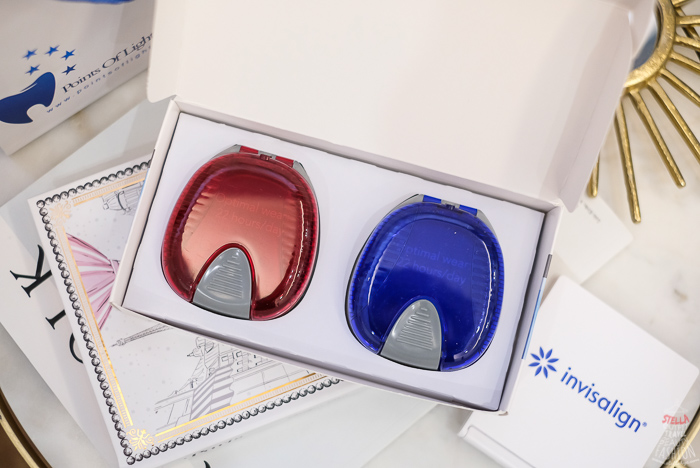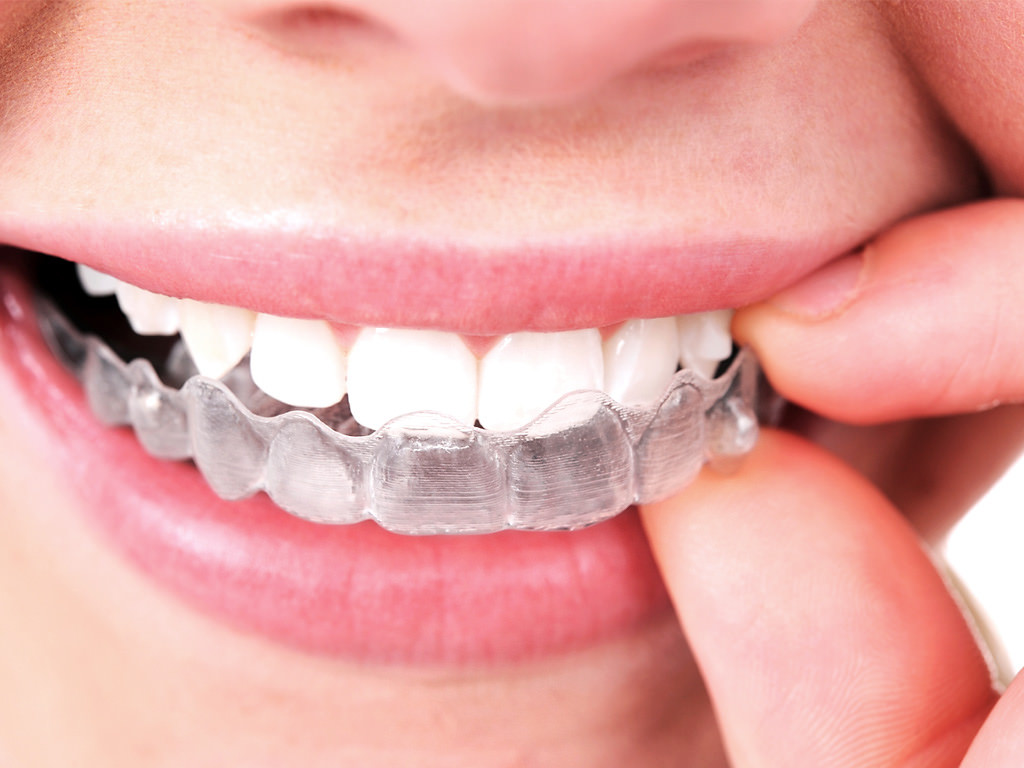A big part of Invisalign’s popularity is that, unlike with regular braces, wearers of the clear aligners can take them out to eat whatever they want. While that’s convenient, it also presents the problem of what to do with Invisalign when eating.
Proper care of Invisalign aligners is essential. Their success for straightening teeth depends on the patient wearing them for the recommended amount of time each day. If they’re broken or lost, they can’t do their job.
Never Eat With Invisalign In Your Mouth
One of the main requirements of Invisalign is that patients always take them out when eating. The same goes for drinking anything other than water.
Invisalign trays are made of durable plastic, but they’re not indestructible. The force used to chew food can bend or break them. Extreme temperatures can also harm them, which is part of the reason why beverages are off-limits. Drinking anything other than water can also stain the clear plastic.
Does that make clear liquids besides water okay? Unfortunately, no. The other reason why drinking or eating anything with Invisalign is a bad idea is bacteria. Bacteria causes plaque to build up on teeth, which can lead to cavities. Add Invisalign trays and you could be trapping that bacteria on the teeth until you have the chance to remove them and brush. Meanwhile, tooth decay has a chance to spread.
So, while a clear soda or even a few licks of something soft like ice cream might seem like it’s safe, it’s best to refrain from all eating and drinking while wearing aligners.
Store Invisalign Correctly When Eating

When patients get their series of Invisalign aligners, they also receive a protective case. This is the best place to keep Invisalign trays while eating. Patients should get in the habit of carrying the case everywhere so it’s handy when they want to eat, drink, or remove the aligners for any reason.
Some people find it helpful to buy additional cases to make storing Invisalign trays more convenient. For example, having one for home and one to keep at work eliminates the need to carry a case back and forth. Invisalign offers cases with a variety of unique designs, so they’re not only a useful tool, but a stylish or fun accessory.
Any sturdy case will do, as long as it protects the aligner when it’s not on the teeth. Similar products to those available through Invisalign can be found at any drugstore for use with other dental devices like retainers or dentures.
What Not to Do With Invisalign When Eating
Without a protective case, people end up putting their Invisalign in a number of less-than-ideal places when they eat. With no other options, they might lay them on their plate, or tuck them into a pocket or purse. Quite often, they set them on the table wrapped in a paper napkin.
First of all, (in addition to being gross) doing any of these gives bacteria a chance to collect on the aligner trays. If they’re not thoroughly cleaned before they’re put back in, all of those germs are going straight into your mouth.
While they’re laying around out in the open, or jostling around at the bottom of a purse, Invisalign can crack or bend. Patients should never use damaged trays. Each set of aligners are custom fit to move the teeth in a precise way. If the shape of the trays isn’t intact, it can fail to work, or worse, push the teeth in the wrong direction. In some cases, patients can move on to the next set in the series. Each set is typically worn for two weeks, so where the patient is in that timeframe is important. Sometimes it’s better to get a replacement. It’s best to consult the dentist if anything happens to the Invisalign trays.
Lastly, when not in a case, it’s easy to misplace Invisalign or, especially if they’re wrapped in a napkin, they might be accidentally thrown away. Just like with a broken tray, it might be possible to skip to the next set in the series, but again, it depends how many days are left for those trays.
On average, Invisalign costs between $2,500 and $7,000. Replacement aligners will cost extra, plus having to wait could disrupt the progress in straightening the teeth. Getting in the habit of placing Invisalign in a case when eating is a much more practical and economical alternative.
More Invisalign Care Guidelines

In addition to keeping Invisalign trays in a case whenever they come out of the mouth, there are other guidelines that wearers should follow. These will protect the aligners, as well as the patient’s teeth and dental health.
Practice Good Dental Hygiene
Even if Invisalign is kept safely in its case while eating, the trays shouldn’t be put onto teeth that haven’t been cleaned. Bacteria or even bits of food can cling to the teeth after eating and drinking. Ideally, patients should brush and floss before placing Invisalign back in their mouth.
We recognize that this may not always be realistic when away from home. You could carry a kit with not only an Invisalign case, but also a travel toothbrush and toothpaste. If that isn’t possible, the next best thing is to thoroughly rinse the mouth with water after eating or drinking and brush as soon as you are able.
Cleaning Invisalign
It’s recommended that Invisalign trays are rinsed with water when removed, and again when they’re put back on the teeth. In addition, brush them gently with a soft toothbrush during regular teeth brushing. The plastic can be scratched, so it’s best to be very gentle and use a non-abrasive toothpaste.
Invisalign also has a cleaning system to soak the trays in. This will disinfect and freshen them while cleaning off any plaque that collects.
Keep Track of Wear Time
Invisalign are meant to be worn for 20 to 22 hours each day. This leaves only 2 to 4 hours a day for meals and snacking. That might not seem like a problem but the time can tick away fast. And it doesn’t take into account any other times a patient might want to remove the trays throughout the day.
For this reason, it’s a good idea to cut down on time spent snacking. For those who are used to sipping on sodas or coffee all day, it could take some getting used to. Wearing Invisalign does take some self-discipline, so it might not be the best teeth straightening option for everyone.
Many people have success with Invisalign and love its versatility and discreteness. If you can follow the guidelines—including storing Invisalign safely when eating—you could be on your way to straight teeth.Click on our “make an appointment” button and we’ll match you up with a dentist who provides Invisalign in your area.


